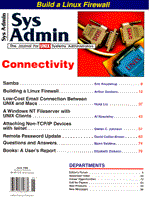
Sidebar: Obtaining Linux
Linux has been, and still is, developed on the Internet. Therefore, the source is also available on the Internet. Two main ftp servers offering the Linux source are:
tsx-11.mit.edu:/pub/linux sunsite.unc.edu:/pub/Linux
Downloading a Linux distribution and all the supporting packages can be tedious. So, I recommend buying one of the available CD-ROM distributions. A good CD-ROM distribution will greatly simplify the task of getting a complete working Linux system running. One of the most popular Linux distributions is Slackware. As of this writing, the most current release is Slackware 3.0. This release offers a complete setup for a standalone or networked Linux system. I used the Slackware release as a starting point for constructing the firewall. Although the Slackware release simplifies the installation process, you still should be prepared to do a lot of tweaking and twiddling. The standard distribution does not come close to being a secure firewall setup. The slackware distribution is commonly "bundled" with Linux books. The Yggdrasil "Plug 'n Play" distribution is also available at many larger bookstores. If you decide to use a CD-ROM distribution, check that you have a Linux-supported CD-ROM drive. Although drivers are available for nearly every drive you can imagine, the precompiled kernels supplied with the distribution will usually support only the most common CD-ROM drives. You need to be able to mount the CD-ROM using one of these precompiled kernels if you are to conveniently install from the CD-ROM. If the precompiled kernels don't support your CD-ROM, don't panic. You may be able to copy the necessary software packages to a DOS partition on the same machine and install it from there. Also be warned that there is considerable lag between CD-ROM mastering and kernel development. It is unlikely that you will find the 1.3.68 kernel mentioned here on any of the current CD-ROM distributions. In fact, some of the current bundled CD-ROMs are still using a 1.0.x or 1.1.x kernel. You should check carefully before you buy. A 1.2.x or later kernel will be much easier to upgrade to function as a firewall.
|